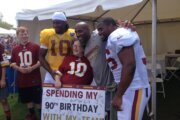Distributions from individual retirement accounts before age 59 1/2 typically trigger a 10% early withdrawal penalty. But the IRA withdrawal rules contain several exceptions to the penalty if you meet certain circumstances or spend the money on specific purchases. If you understand the guidelines, you can avoid paying extra fees.
Some ways to avoid the IRA early withdrawal penalty include:
— Delay IRA withdrawals until age 59 1/2.
— Use the funds for large medical expenses.
— Purchase health insurance after a layoff.
— Pay for college costs.
— Fund part of a first home purchase.
— Defray birth or adoption costs.
— Manage disability expenses.
— Cover the cost of military service.
— Set up an annuity.
— Consider a Roth IRA withdrawal.
— Take a distribution from an inherited IRA.
— Leave the money in a 401(k).
Read on for more information on each strategy to avoid early IRA withdrawal penalties.
Delay IRA Withdrawals Until Age 59 1/2
You can avoid the early withdrawal penalty by waiting until at least age 59 1/2 to start taking distributions from your IRA. Once you turn age 59 1/2, you can withdraw any amount from your IRA without having to pay the 10% penalty.
Regular income tax will still be due on each IRA distribution. You can continue to defer paying income tax on the funds in your IRA until you withdraw the money from the account. Traditional IRA distributions are not required until after age 72, with the exact age depending on your birth date.
[Related:Retirement Planning Mistakes to Avoid]
Use the Funds for Medical Expenses
You may be able to take out funds early if you have an unexpected health event. “IRA distributions used to pay for medical expenses that are not reimbursed by health insurance and exceed 10% of your adjusted gross income are penalty-free,” says Brittany Pederson, director of deposits and payments for Georgia’s Own Credit Union in Atlanta.
To find out the maximum amount you could withdraw from your IRA without penalty, add up the amount you paid for unreimbursed medical expenses in the year you took the distribution and subtract 10% of your adjusted gross income for the same year. You don’t have to itemize your taxes to take advantage of the penalty exception for medical costs.
Purchase Health Insurance After a Layoff
Unemployed individuals may be able to take early IRA withdrawals without penalty to cover the cost of health insurance premiums. “If you lose your job and collect unemployment compensation for 12 consecutive weeks, you can avoid penalties if you use the money to pay for health insurance,” Pederson says. The insurance could cover you, your spouse and your dependents.
To qualify for this penalty exception, you must take the distribution in the year you received the unemployment compensation or the following year, and before you have been re-employed for 60 days or more.
[Related:What Is the Average Retirement Savings Balance by Age?]
Pay for College Costs
Penalty-free IRA distributions are allowed to pay for college. “This includes tuition, fees, books, supplies and equipment required for enrollment or attendance at an eligible educational institution,” says Thomas Codevilla, partner at SK&S Law Group in Denver. Room and board also count if the individual attending college is at least a half-time student.
The education must be for the account owner, his or her spouse, or their children or grandchildren. Qualifying institutions include colleges, universities and vocational schools eligible to participate in federal student aid programs. IRA withdrawals are considered taxable income and could reduce the student’s eligibility for financial aid.
Fund Part of a First Home Purchase
An early IRA withdrawal can be used to help fund a first home purchase. You can withdraw up to $10,000 ($20,000 for couples) from an IRA to buy or build a first home without incurring the early withdrawal penalty. To qualify for the exception, you must not have owned a home for the two years preceding the home purchase.
“The funds withdrawn from the IRA must be used to pay for the acquisition costs by the 120th day after the distribution is received,” says David Edmisten, founder of Next Phase Financial Planning LLC in Prescott, Arizona. This type of early IRA withdrawal can also be used to help purchase a first home for a child, grandchild or parent.
Defray Birth or Adoption Costs
A child’s arrival may require more expenses to cover basic needs. “Parents of newborns can withdraw up to $5,000 following the birth or adoption of a child,” Pederson says. “The distribution must be taken within one year of birth or adoption.” If financial circumstances improve, parents have the option to put the money back into the account to accumulate for retirement.
Manage Disability Expenses
People with severe physical and mental disabilities who are no longer able to work may need extra funds. “Disabled individuals can take penalty-free withdrawals from their retirement accounts,” Edmisten says. “The IRS requires proof of disability and substantiating documentation should be obtained from a physician.” Conditions that qualify for the penalty exemption are generally expected to be of long, continued or indefinite duration and result in death.
[READ: How to Save $1 Million by Retirement]
Cover the Cost of Military Service
Members of the military could withdraw funds as needed. “In most cases, those who take an IRA distribution during active military duty are not subject to an early withdrawal penalty,” Pederson says.
The penalty exception is available to those ordered or called to duty after Sept. 11, 2001, for a period of more than 179 days. The distribution must be taken during the active duty period to avoid the penalty. Qualified reservist distributions may be available to members of the Air Force Reserve, Air National Guard of the United States, Army National Guard of the United States, Army Reserve, Coast Guard Reserve, Marine Corps Reserve, Naval Reserve or Reserve Corps of the Public Health Service.
Set up an Annuity
IRA withdrawals taken as a series of annuity payments are not subject to the early withdrawal penalty. The use of an IRS-approved distribution method and at least one withdrawal annually are required to avoid the penalty. The payments are calculated based on your life expectancy or the joint life expectancies of you and your beneficiary, and generally require professional assistance to calculate.
“This method can offer additional flexibility as the distributions can begin at various ages and can end after the required time periods have been met,” Edmisten says.
Consider a Roth IRA Withdrawal
A Roth IRA early withdrawal often has fewer restrictions and penalties than a traditional IRA distribution if you need access to your retirement savings before age 59 1/2. You may be able to withdraw your contributions, but not the earnings, from a Roth IRA that is at least five years old without incurring the early withdrawal penalty.
If you don’t have a Roth IRA, you could look at creating one. “You convert a portion of your traditional IRA funds into a Roth IRA each year, paying income taxes on the converted amount,” Codevilla says. “By systematically converting over time, you create a ladder of funds accessible without penalties.”
Take a Distribution From an Inherited IRA
You could tap an IRA you receive from a relative in certain circumstances. “If you inherit a traditional IRA before age 59 1/2, you can take penalty-free withdrawals, but you will be required to pay income tax on any distribution,” Pederson says.
If the original account owner passed away after Jan. 1, 2020, you will be required to withdraw all assets from the inherited IRA within 10 years of the IRA owner’s death, unless you are a surviving spouse, minor child, disabled, chronically ill or up to 10 years younger than the original account owner. However, if you inherit an IRA from your spouse and elect to treat it as your own, distributions before age 59 1/2 will be subject to the early withdrawal penalty.
Leave the Money in a 401(k)
Workers who leave their jobs in the year they turn 55 or older can withdraw money from their 401(k) without having to pay the 10% penalty. Qualified public safety employees can begin taking penalty-free withdrawals if they leave service in the year they turn 50 or older.
If that money is rolled over to an IRA, you will have to wait until age 59 1/2 to avoid the penalty, unless you qualify for one of the other early withdrawal penalty exceptions. If you will need the money in your 401(k) plan between ages 55 and 59 1/2, you should delay rolling the money over to an IRA in order to avoid triggering the early withdrawal penalty.
If you’re unsure of your eligibility, ask a professional to help you decipher the fine print. “It’s important to know the rules and limitations before deciding to make an early withdrawal,” Pederson says.
More from U.S. News
10 Retirees Share Their Biggest Regrets
Great Senior Discounts for 2023
12 Ways to Avoid the IRA Early Withdrawal Penalty originally appeared on usnews.com
Update 07/21/23: This story was previously published at an earlier date and has been updated with new information.







